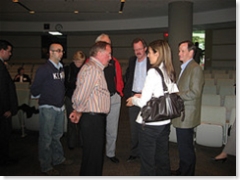![]() Shel Israel was the featured speaker today at OCRI Zone5ive’s first session of the year for technology marketers.
Shel Israel was the featured speaker today at OCRI Zone5ive’s first session of the year for technology marketers.
PowerPoint has a lot to do with a traditional way of thinking. I talk at you. My slides establish that I am the authority.
That was then. This is now.
Effective communication involves conversation. And blogging enables conversation. One to one conversations that scale to one to many and many to many.
The conversation is fundamental to marketing. But it has become divorced from the marketing that has been happening for the last 50 years.
Marketing at its base was word of mouth. The local butcher. The local shoemaker. Talking to the local resident.
 However, word of mouth was unable to scale with the development of mass production, mass media and ultimately, mass marketing.
However, word of mouth was unable to scale with the development of mass production, mass media and ultimately, mass marketing.
Now, we are in a period in which audiences for mass media audiences are splintering and shrinking. And mass marketing is not as effective as it once was.
We are entering a time in which people can speak directly to one another about what they believe, what they like, about their passions. And others read and listen to this.
Smart companies are recognizing that their blogging employees can put a human face on the company and its products. And they can engage in conversations with people who care the most.
The Edelman Trust Barometer this year indicated that the most trusted source of information is “People like me.” Not the traditional institutions.
Sidenote: In a room full of marketers, only two people raised their hands when Shel asked whether anyone knows who Richard Edelman is.
When you understand what people are thinking, then you can decide what the wise course of action may be. If you want to hear what people think, start a blog. They’ll tell you what they want and need.
 Blogging allows the conversation of two people who know and trust one another to scale around the globe.
Blogging allows the conversation of two people who know and trust one another to scale around the globe.
Good marketing will take the customer out from the edge of the company and bring them into the center. Blogging can achieve this.
Dell is coming to terms with the need for and the potential of blogging. They have moved from their position of unresponsiveness at the time that Jeff Jarvis proclaimed he was in “Dell Hell” to launch their own blog. And while that blog was widely criticized in its early stages, they have learned and responded. Dell has changed. They have become part of the conversation. And their perspective is being shared.
The adoption of blogging by corporations has been slow to develop. But as they become more familiar with its potential, the pace of adoption will accelerate.
HR is the first place that should blog. New recruits will judge a company by its bloggers. The company that wants to attract the MySpace generation will supply new employees with an employee blog at the same time that they receive their telephone, their computer and their security pass. And they won’t be told they have to blog. Nor will they be told what to blog. This will send a signal to them that their employee understands the evolving world and trusts them to behave responsibly.
Something very fundamental has changed. One way communications to two way communications. The traditional advertising vehicles are becoming more expensive at the same rate they are becoming less effective. As a new generation comes into the mainstream, they will expect marketing to be conversational.

 Blog readers continue to be treated to an unusual peek behind the scenes in the development of a web 2.0 company.
Blog readers continue to be treated to an unusual peek behind the scenes in the development of a web 2.0 company. Stowe Boyd offers some
Stowe Boyd offers some 
 When PR types boast that social media belongs to PR because we understand conversation better than advertising, ask why it was an advertising agency that did
When PR types boast that social media belongs to PR because we understand conversation better than advertising, ask why it was an advertising agency that did 
 Management guru and author
Management guru and author 
 Munjal Shah, the CEO of
Munjal Shah, the CEO of 